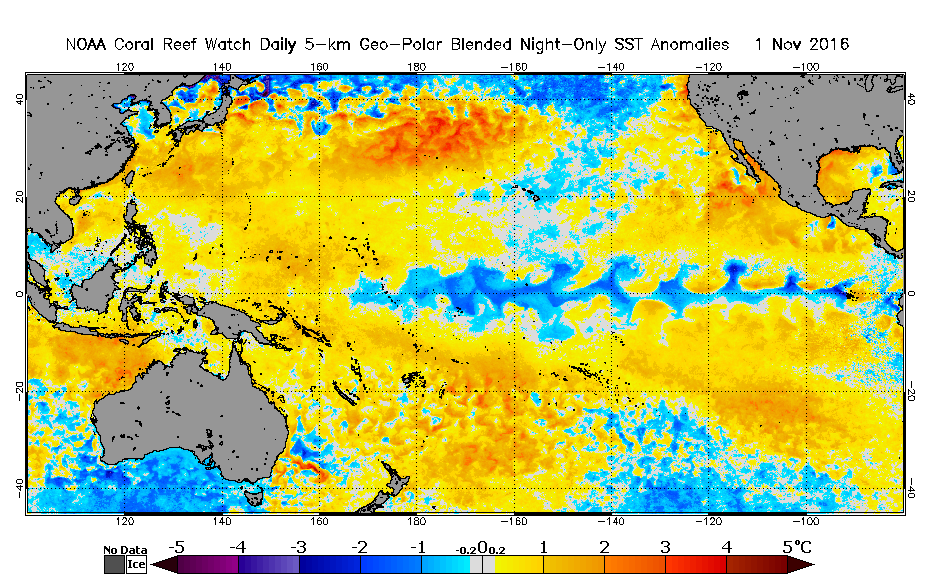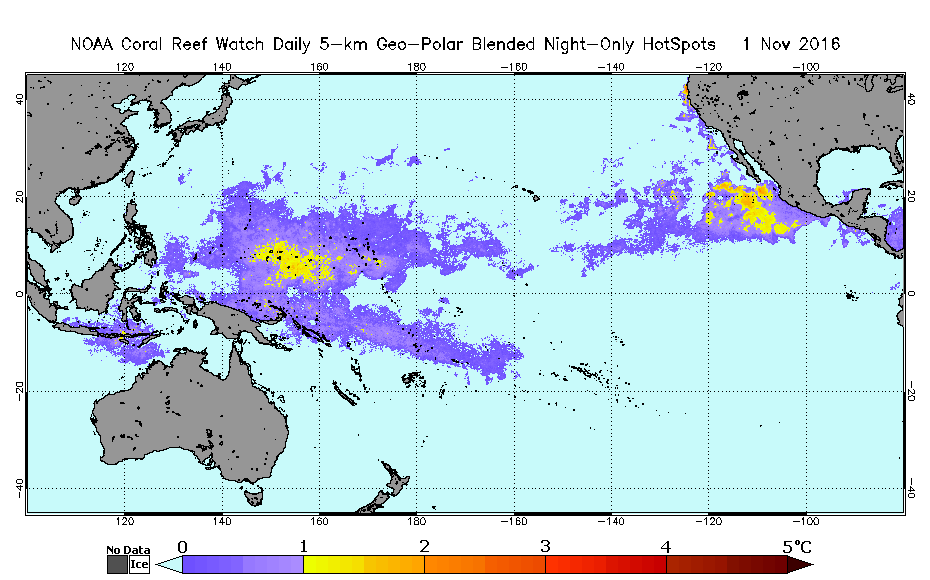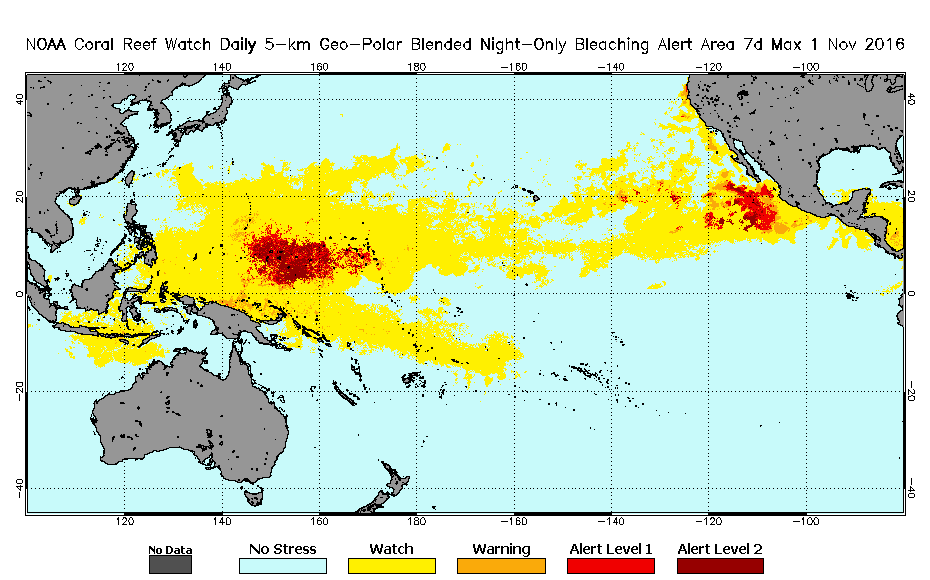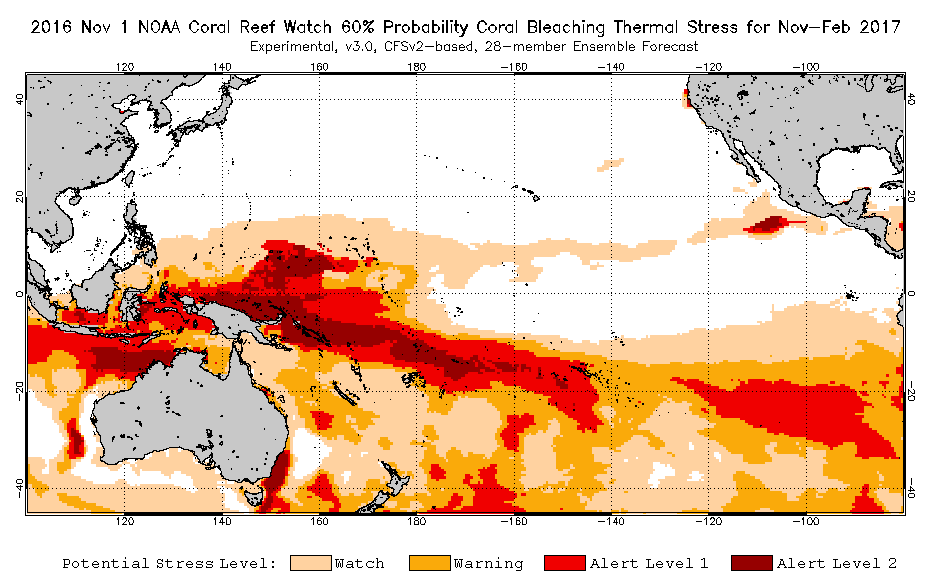Coral Bleaching Thermal Stress Analysis and
Seasonal Guidance through February 2017
(Released November 3, 2016)
Current conditions:
NOAA Coral Reef Watch's (CRW) near-real-time satellite monitoring shows very dynamic but sustained negative sea surface temperature (SST) anomalies expanding across the eastern and central equatorial Pacific from the Galapagos Islands to the Gilbert Islands (Figure 1). This structure is associated with La Niña development. The Main Hawaiian Islands are showing normal to below-average temperatures for this time of year, and the Hawaiian island chain has not seen a significant threat of bleaching this year. Positive anomalies have persisted in the western Pacific from Guam to the Marshall Islands, including the Federated States of Micronesia (FSM). A positive SST anomaly is also present off the western coast of Mexico, with the exception of a nicely visible upwelling present in the Gulf of Tehuantepec. As of October 2016, La Niña conditions have a 70% chance of developing during Northern Hemisphere autumn and a slight chance (~55%) of persisting through winter 2016-17.

|
||
|
Figure 1. NOAA Coral Reef Watch's Satellite Sea Surface Temperature (SST) Anomaly product for the Pacific region. |
||
HotSpots are beginning to migrate into the Southern Hemisphere but remain concentrated around the eastern FSM (Figure 2). As of the end of October 2016, bleaching stress is no longer present around the Ryukyu Islands of Japan and Taiwan. Guam and the Commonwealth of the Northern Mariana Islands are currently at a Bleaching Warning but are expected to be stress-free by the end of November (Figure 3). The Marshall Islands are at Alert Level 1 with possible relief as early as the end of November. The eastern FSM has been at Alert Level 2 since the beginning of September. This high level of thermal stress is expected to remain until the end of December, as warm temperatures migrate southward toward Papua New Guinea and the Solomon Islands, which are both currently at Bleaching Watch status. A Bleaching Watch also has been issued for the Gilbert Islands, Tuvalu, the Northern Cook Islands, and as far south as Wallis and Futuna and American Samoa, where bleaching thermal stress usually does not appear this early (Figure 3). Unusually calm weather has been reported by local partners in American Samoa for the last several weeks. In addition, coral bleaching has been underway at Kwajalein, Marshall Islands, the fourth event in seven years (2009, 2013, 2014, and this year), with no serious events prior to that. Bleaching also has been reported in eastern Micronesia.

|
||
|
Figure 2. NOAA Coral Reef Watch's Satellite Coral Bleaching HotSpot product for the Pacific region. |
||

|
||
|
Figure 3. NOAA Coral Reef Watch's Satellite Bleaching Alert Area (7-day maximum) product for the Pacific region. |
||
CRW's most recent Four-Month Coral Bleaching Thermal Stress Outlook (Figure 4) projects thermal stress to be highest around Papua New Guinea and the Solomon Islands at the beginning of 2017. Temperatures are expected to continue to increase around American Samoa, and bleaching stress may eventually reach southern Tonga, the Cook Islands, and the Society Islands by the end of February/early March 2017.

|
||
|
Figure 4. NOAA Coral Reef Watch's Four-Month Coral Bleaching Thermal Stress Outlook for November 2016-February 2017 for the Pacific region. |
||
NOTE: This report focuses on NOAA Coral Reef Watch's new 5-km satellite-based coral bleaching thermal stress products and new v3.0 Four-Month Coral Bleaching Thermal Stress Outlook. The 5-km satellite products presented here use CRW's new color scales, which are already implemented in the images posted on the CRW website.
To monitor the intensity and location of the coral bleaching thermal stress, please follow NOAA CRW's satellite monitoring and Outlook closely in the coming weeks at: http://coralreefwatch.noaa.gov/satellite/bleaching5km/index.php and http://coralreefwatch.noaa.gov/satellite/bleachingoutlook_cfs/outlook_cfs.php.
CRW's current satellite and modeled products can be found at:
http://coralreefwatch.noaa.gov/satellite/index.php
CRW's Four-Month Coral Bleaching Thermal Stress Outlooks can be found at:
http://coralreefwatch.noaa.gov/satellite/bleachingoutlook_cfs/outlook_cfs.php
CRW's 5-km satellite Regional Virtual Stations can be found at:
http://coralreefwatch.noaa.gov/vs/index.php
Sign up for automated bleaching alert emails for CRW's 5-km Regional Virtual Stations at:
http://coralreefwatch-satops.noaa.gov/
CRW's 50-km satellite Virtual Stations can be found at:
http://coralreefwatch.noaa.gov/satellite/vs.php
Please report bleaching events (or non-events) at:
http://www.reefbase.org/contribute/bleachingreport.aspx
Disclaimer
The content posted on this web page solely represents the opinions of the authors and does not constitute a statement of policy, decision, or position on behalf of NOAA or the US Government.
The appearance of external links on this World Wide Web site does not constitute endorsement by the Department of Commerce/National Oceanic and Atmospheric Administration of external Web sites or the information, products or services contained therein. For other than authorized activities, the Department of Commerce/NOAA does not exercise any editorial control over the information you may find at these locations. These links are provided consistent with the stated purpose of this Department of Commerce/NOAA Web site.